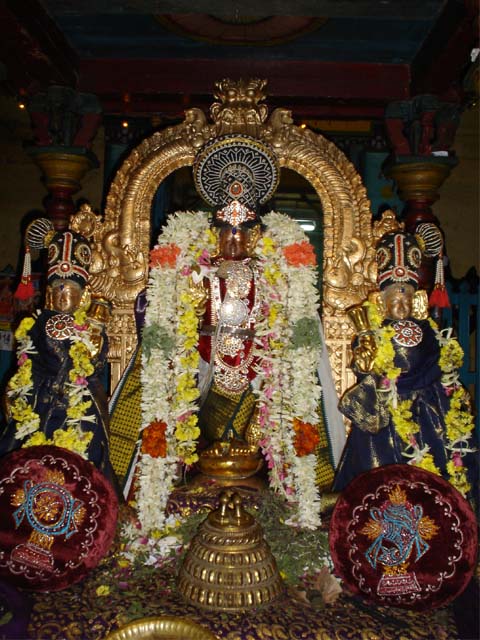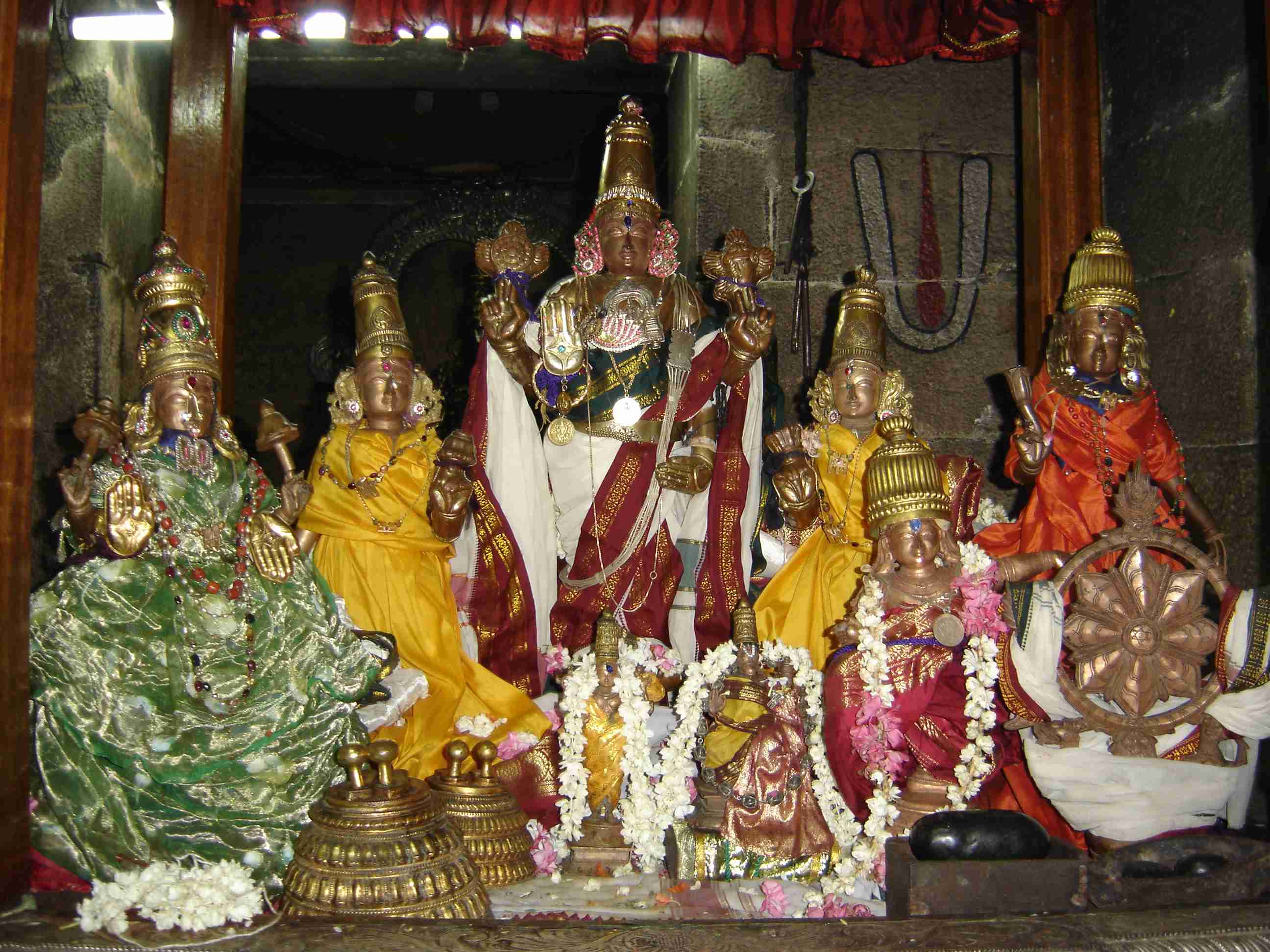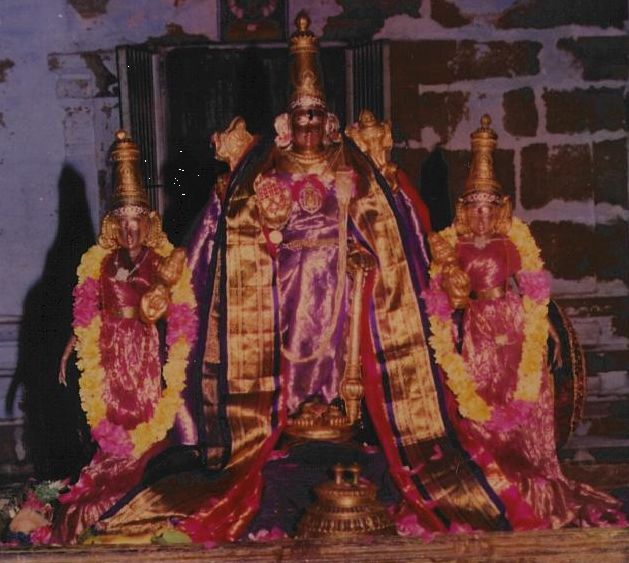Dharmasamstapa nartaya sambhavami yuge yuge ||
Sri Krishna tells in Gita that protecting the good, destroying the bad and establishing Dharma are important actions of the Lord. The purpose of His Avatar is these Three only. In this Chapter 11, Arjuna sees in the Viswaroopa Image of the Lord, good persons and also finds evil persons entering His mouth, destroyed, and again get spewed out. Whichever side or directions Arjuna looked, he found the Lord's presence without any exception. He was astonished to see the various colors and Devas, Gandarvas, Yakshas,etc., on the image. He was also frightened. He has been explaining what he saw and why he was frightened. We have to see the sloka 25 now. Visiting Sri Pavalavannan, we were able to realize to some extent the colors on the Lord's image.

But in Sri Pavalavannan, we could see only the red color of the coral, though in the Viswaroopam, multi colors were displayed. Therefore, along with Sri Pavalavannan, another sannidhi also we have to see. He is Sri Pacchaivannan [ஸ்ரீ பச்சை வண்ணன்]. This sannidhi is separate and outside Sri Pavalavannan sannidhi. Both the sannidhis are looked after by same person. Sri Pacchaivannan is fully green in color. Moolavar is in standing pose with right arm in abhaya mudra and left arm in kati mudra. Utsavar also shows abhaya and graces along with Sri Sridevi and Sri Bhudevi. Sri Thayar is Sri Mragathavalli Thayar. Accompanied by Two elephants on the sides showering water on Her, Sri Thayar captivates all the devotees. Moolavar of Sri Thayar is established on Sri Lakshmi Yanra [ஸ்ரீ லக்ஷ்மி யந்த்ரம்], preapred as per shastras. Therefore, we worship Sri Thayar sprouting from the Yantra. Another speciality is that the Adisesha lamp in the sannidhi is always glowing. In Srimad Ramayana, Sri Rama asked Lakshmana, incarnation of Adisesha to guard Sri Sita, while He chased the deer to capture; but, Lakshmana left Sri Sita unguarded and came to Sri Rama on hearing the voice of the demon in the form of deer. To compensate for that mistake, here Adisesha in the form of a lamp, guards Sri Maragathavalli Thayar always. We can worship Sri Maragathavalli Thayar as Sri Sita, the Lord Sri Pacchaivanna as Sri Rama and the lamp as Lakshmana. Today's [31st October 2008] lecture is from a mandapam in sri Pavalavanna temple, where a mirror room [கண்ணாடி அறை] is the centrepiece. We see many homa kunds. Sri Varadaraja, during brahmotsavam festival, on the 5th day, arrives here in the morning and remains for about Three hours. Thus, this mandapam is famous for. Thirumangai Alwar has praised this Kshetram in one pasuram. He says, 'Pavalavanna! Enguthai emperuman unnai nadi adiyen ezhaiyen! ' [பவளவண்ணா! எங்குத்தாய்? எம்பெருமான் உன்னை நாடி அடியேன் ஏழையேன்!]. That is, Alwar says he suffered a lot in searching for the Lord everywhere. While commenting on this pasuram Swami Periyavachan Pillai [பெரியவாச்சான் பிள்ளை] noted that Alwar stretced his hands in search of the Lord. Alwar wondered why he was unable to recognise, in spite of the Coral Light of the Lord. This could be one meaning for the word enguthai in the pasuram. In Srimad Ramayana, after Sri Rama departs to the forest, Dasaratha cries and searches for Sri Rama. He tells his wife Kausalya, near him, that he was unable to see her and so she should touch Dasaratha to know whether he was still alive or not! Similarly, Alwar is searching for the Lord. This is another interpretation. By addressing the Lord as Emperuman, that is our Owner, Alwar suggests that he and also all of us are the Property of the Lord. Owner should always keep the property with Him and He should even go to a court and claim the property. Here, Alwar laments that the property is searching for the Owner, to be claimed. Alwar accuses the Lord it was unjust to make the property search for the Owner. Alwar says that he did not know where the Lord had gone and looks in all directions. Similarly, Arjuna tells that he did not know in which direction the Lord was, after seeing the Viswaroopam. Sloka 25:
damstra-karalani ca te mukhani
drishtvaiva kalanala-sannibhani
diso na jane na labhe ca sarma
prasida devesa jagan-nivasa
"O Lord of lords, O refuge of the worlds, please be gracious to me. I cannot keep my balance seeing thus Your blazing deathlike faces and awful teeth. In all directions I am bewildered."
He addresses the Lord as Devesa and Jagan-nivasa. Devesa = Leader of Devas, jagan-nivasa = having the Universe in Him. He is the Commander of Devas. We name our houses as Nivasam; but, This Nivasam is very huge and the entire Universe is accommodated in it. Damshtra-karalani = frightening teeth, te = [in] Your [Sri Krishna's], mukhani = various faces, drishtva =seeing, eva = and so. That is, just by seeing the teeth and faces of the Lord's image in Viswaroopam, Arjuna is frightened. Neither he nor the Lord touched each other. Still, he feels afraid. Kala = doomsday, anala =fire, sannibhani = like [faces]. Arjuna sees doomsday fire like faces or faces raging with doomsday fire, and frightening teeth. Disa =directions, na jane = not knowing. Arjuna is perplexed and seeing the faces of the Lord in Viswaroopam, everywhere, he is not aware of the directions, whether the faces were facing South, West, North or East! When we visit temples we are able to distinguish the direction in which the Lord is facing. But here, Arjuna sees faces everywhere! This can be compared to the word enguthai, cried by Alwar. Alwar cried because he lost sight of Him; while here, Arjuna is seeing the Lord in Viswaroopam and so in fear he is unable to find the directions. Sarma = comfort or happiness, na labhe = not got. That is, he is sorrowing, out of fear. Prasida = have mercy [on Arjuna], Devaesa, Jagan nivasa! Why should Arjuna plead for mercy on him? Was the Lord about to punish Arjuna? No. Arjuna requests the Lord to mercifully eliminate his fear! Jagan-nivasa means supporter of the Universe. Entire Universe is seen in the Viswaroopam. That means this coutry Bharat, the place Kurukshetra, battle field and the warriors must also be seen. Arjuna also must be seen. In that case is Arjuna now on the body of the Lord or is he still by the side of the chariot in the battle field? Arjuna saw all including himself and other warriors on the image of the Lord; and also, all, including Arjuna, were in their respective places! How this was possible? This is called akatithagatana shakti [அகடிதகடனா சக்தி]. It is an unimaginable power of the Lord. The Lord swallows entire Universe and has it in His stomach. Then, as a small infant, He is seen chewing His toe and reclining on a tender banian tree leaf! Alwar wonders how, when the entire Universe was swallowed, the banian tree with all leaves also should have been swallowed. Then, how the Lord is reclining on a single leaf? That is akatithagatana shakti! Similarly Arjuna is seeing from outside his own image on the Viswaroopam. Thus he is confused about directions. Fear brings in gloom and so he prays the Lord to have mercy on him and restore him normalcy so that he could appreciate the Lord and pay respects. We will now take leave of this Kshetram.













